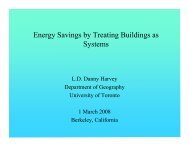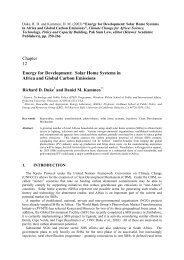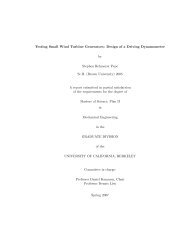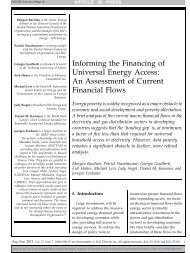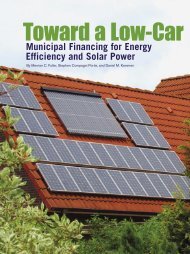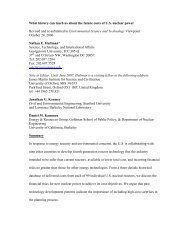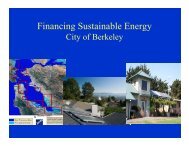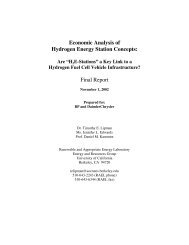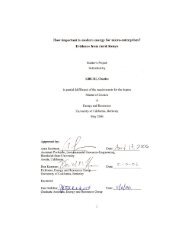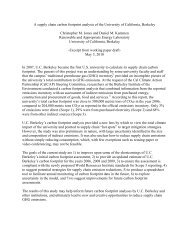Renewable Energy Sector Development in the Caribbean: Current ...
Renewable Energy Sector Development in the Caribbean: Current ...
Renewable Energy Sector Development in the Caribbean: Current ...
Create successful ePaper yourself
Turn your PDF publications into a flip-book with our unique Google optimized e-Paper software.
<strong>in</strong>stallations island-wide (Epp, 2009). S<strong>in</strong>ce <strong>the</strong> late 1990s Solar Dynamics has expanded to ownmanufactur<strong>in</strong>g operations <strong>in</strong> Sa<strong>in</strong>t Lucia, a distribution center <strong>in</strong> Jamaica and agents <strong>in</strong> <strong>the</strong>Bahamas, Belize, Dom<strong>in</strong>ica, Grenada, Guyana, St. Maarteen, St. V<strong>in</strong>cent & <strong>the</strong> Grenad<strong>in</strong>es, St.Kitts & Nevis and <strong>the</strong> British Virg<strong>in</strong> Islands (CARICOM <strong>Energy</strong> Programme, 2010).Government support of <strong>the</strong> SWH <strong>in</strong>dustry is an <strong>in</strong>dication of its <strong>in</strong>terest <strong>in</strong> local energyresources. Fur<strong>the</strong>rmore, unlike most Eastern <strong>Caribbean</strong> States, <strong>the</strong> government has a majoritystake <strong>in</strong> BLP with <strong>the</strong> National Insurance Board be<strong>in</strong>g <strong>the</strong> largest shareholder. However <strong>the</strong> 1907Electricity Supply Act and <strong>the</strong> 1951 Public Utilities Act of 1951 are to date <strong>the</strong> only major piecesof legislation that govern <strong>the</strong> power sector, mak<strong>in</strong>g it difficult for IPPs to potentially market<strong>the</strong>mselves to <strong>the</strong> utility company. The National <strong>Energy</strong> Policy was published by <strong>the</strong>Government <strong>in</strong> 2007 and <strong>in</strong> 2010 <strong>the</strong> Fair Trad<strong>in</strong>g Commission approved a <strong>Renewable</strong> <strong>Energy</strong>Rider pilot project which allows eligible customers with renewable power sources to sell excesspower to <strong>the</strong> grid. The program currently limits size to 5kW for domestic and 50kW for o<strong>the</strong>rtariff brackets. All kWh supplied to <strong>the</strong> grid are credited for 1.8 times <strong>the</strong> Fuel ClauseAdjustment or 31.5 cents/kWh, whichever is greater (BL&P, 2011).It is difficult to judge <strong>the</strong> program’s success after only a few months, however it seems that <strong>the</strong>capital costs of PV systems and <strong>the</strong> lack of f<strong>in</strong>anc<strong>in</strong>g options is a major barrier. Oil price<strong>in</strong>creases may make <strong>the</strong> program more attractive <strong>in</strong> <strong>the</strong> near future but to date <strong>the</strong>re has been less<strong>in</strong>terest shown than expected. While acknowledg<strong>in</strong>g <strong>the</strong> recent launch of <strong>the</strong> <strong>Renewable</strong> <strong>Energy</strong>Rider pilot project, o<strong>the</strong>r <strong>in</strong>itiatives from <strong>the</strong> Fair Trad<strong>in</strong>g Commission will be needed toencourage <strong>the</strong> utility to explore new generation and markets.2.3. W<strong>in</strong>d <strong>Development</strong> <strong>in</strong> JamaicaThe Jamaica Public Service Company Limited (JPS) is <strong>the</strong> sole distributor of electricity <strong>in</strong>Jamaica, <strong>in</strong>herit<strong>in</strong>g an electricity sector that dates back to 1892, when electricity was firstgenerated on <strong>the</strong> island. Jamaica was one of <strong>the</strong> first countries <strong>in</strong> <strong>the</strong> world to develop electricity<strong>in</strong>frastructure. Initially <strong>the</strong> service was provided through <strong>the</strong> Jamaica Electric Light Company.With<strong>in</strong> <strong>the</strong> com<strong>in</strong>g decades several private electric companies cropped up <strong>in</strong> different towns andthrough a process of consolidation dur<strong>in</strong>g <strong>the</strong> early twentieth century JPS emerged as <strong>the</strong> parentcompany <strong>in</strong> 1923. JPS was granted an all-island franchise <strong>in</strong> 1966, mak<strong>in</strong>g it <strong>the</strong> sole publicsupplier of electricity on <strong>the</strong> island (JPS, 2010).JPS has changed ownership a number of times dur<strong>in</strong>g its history. Start<strong>in</strong>g as a private companyowned by foreign shareholders, it was acquired by <strong>the</strong> Government <strong>in</strong> 1970 but <strong>in</strong> 2001 majorityshareholder ownership was sold to Mirant Corporation, a US based energy service provider thatstill owns <strong>the</strong>se shares after <strong>the</strong>ir chang<strong>in</strong>g hands over <strong>the</strong> years (M<strong>in</strong>istry of <strong>Energy</strong> and M<strong>in</strong><strong>in</strong>g,2006). JPS is a regulated utility with rates subject to <strong>the</strong> Office of Utility Regulation (OUR). In6



